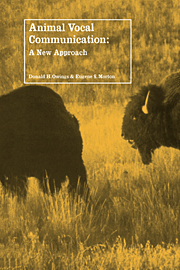Book contents
- Frontmatter
- Contents
- Preface
- Acknowledgments
- Prologue
- 1 Overview of ideas
- 2 The roles of assessment and management in communication
- 3 Form and function in vocal communication
- 4 Mechanisms and proximate processes of vocal communication
- 5 Assessment/management: a viable replacement for the information concept
- Reference
- Index
1 - Overview of ideas
Published online by Cambridge University Press: 05 June 2012
- Frontmatter
- Contents
- Preface
- Acknowledgments
- Prologue
- 1 Overview of ideas
- 2 The roles of assessment and management in communication
- 3 Form and function in vocal communication
- 4 Mechanisms and proximate processes of vocal communication
- 5 Assessment/management: a viable replacement for the information concept
- Reference
- Index
Summary
What concepts have been used to explain the sorts of behavior described in the prologue? The purpose of this chapter is to review the variety of those ideas. The overview is historical in part, but is also organized around Nikolaas Tinbergen's four-part classification of questions that can be posed about behavior - about the evolutionary history and functions of behavior (ultimate questions), and about the immediate regulation and development of behavior (proximate questions). This chapter does not distinguish between the ideas that do and do not form a part of a modern synthesis. Our synthesis is presented in Chapter 2, and is developed from only a portion of the concepts discussed here. The goal in Chapter 2 is to identify that subset of old and new concepts with the greatest capacity to provide an understanding of communicative behavior.
An evolutionary approach: ultimate questions
Natural selection and the functions of behavior
Well over a hundred years ago, Charles Darwin provided the essential elements of the evolutionary framework in which this book is cast. His principle of evolution through natural selection is very powerful, but also so elegantly simple that it can be summarized by just four points (Alcock, 1989). (1) There is variation among the individuals within a species, in body form, physiology, behavior, and so on. (2) Some of this variation is heritable; in other words, some of the distinctive characteristics of individuals can be passed on to their young, so that offspring tend to resemble their parents more than they do other members of the species
- Type
- Chapter
- Information
- Animal Vocal CommunicationA New Approach, pp. 13 - 47Publisher: Cambridge University PressPrint publication year: 1998



